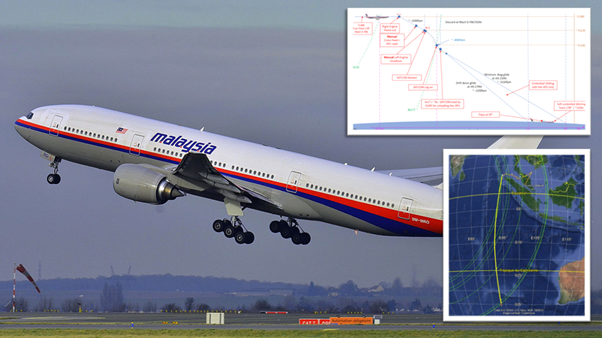Retired Air Traffic Management programme manager Jean-Luc Marchand and ex A330 Captain Patrick Blelly gave a lecture on the MH370 flight’s refined trajectory at the Royal Aeronautical Society (RAeS).
With the disappearance of Malaysian Airlines flight MH370 having occurred over 9 years ago, a new hypothesis as to what happened on March 8, 2014 is gaining attention. An independent group of investigators have been working on finding the true cause of the crash for several years despite the loss of public interest.
The joint leaders of the team, former Union de Transports Aériens (UTA – French long haul airline) A330/A340 Captain Patrick Blelly and Jean-Luc Marchand, MSc gave a presentation about their findings at the RAeS headquarters in London on September 7, 2023.
The new hypothesis focused on the human factors as well as the technical data to eventually suggest a new impact area west of Australia. The team believes the aircraft was intentionally ditched at a location a few hundred kilometres south of the initial zone previously surveyed.
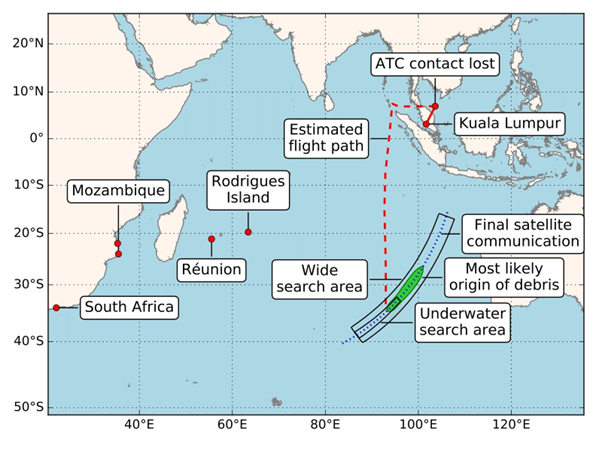
An overview of flight MH370
MH370 was a routinely scheduled flight operated by Malaysian Airlines connecting Kuala Lumpur International Airport to Beijing Capital International Airport. The Boeing 777-200ER had 227 passengers and 12 crew on board when it departed Kuala Lumpur on Mar. 8, 2014, local time. The flight never reached its final destination, and all souls on board were declared missing.
Despite an extensive ocean floor search lasting until January 2018, the wreckage was never found and only a few scattered debris confirmed to have belonged to 9M-MRO have been recovered across the Indian Ocean. Based on publicly available sources the confirmed portion of the flight is as follows.
MH370 took off from Kuala Lumpur runway 32R UTC 16:42 climbing to FL180 then FL250 headed directly to waypoint IGARI. At UTC 16:50 pilot request FL370 but Lumpur Radar ATC clears FL350. The final ACARS (Aircraft Communications Addressing and Reporting System) data transmission is made at UTC 17:07.
At this point satellite communications is lost as well. At UTC 17:19 the flight passed waypoint IGARI and the aircraft is handed over from Kuala Lumpur Area Control Centre to Ho Chi Minh Area Control Centre. However, the flight never contacted the Vietnam control centre.
At UTC 17:21 MH370 disappeared from all civilian ATC radar including Kuala Lumpur ACC radar and Ho Chi Minh ACC. This is a result of the ADS-B transponder being turned off to Standby.
Malaysian military radar that does not rely on aircraft transponder data still tracks the aircraft. The military radar tracks the aircraft immediately veering off its flight path and making a U-turn to the southwest [and it’s still not clear why the military did not respond scrambling interceptors to investigate the potential threat posed by an aircraft that has turned off its transponder and does not reply to the radio calls].
View this post on Instagram
As MH370 reaches the southern end of Penang, Malaysia First Officer Fariq Abdul Hamid’s phone is registered with a cell tower at UTC 17:52. However, only a 2G connection is made so no other data transmission is made. Afterwards the aircraft turns northwest along the Strait of Malacca.
Multiple ACARS data request is sent from the ground to the aircraft around UTC 18:03 but is never received.
At UTC 18:22 the last radar contact from the Malaysian radar installation is made 200 nautical miles northwest of Penang. This is the last known position 10Nm after waypoint MEKAR is the last point the aircraft was accurately tracked. Afterwards the only method of deducing the aircraft’s position is through an hourly automated handshake between the aircraft and the geostationary Inmarsat satellite communication network.
From UTC 19:41 to UTC 00:19 (March 8) a total of 7 handshakes are successfully made. From this, the time difference between the expected time of the aircraft’s message and the actual arrival of the message can be used to calculate the aircraft’s positions. However, it should be noted that this only gives us a circle of where the aircraft could be, rather than its exact location.
Often referred to as Arc 1 ~ 7, these concentric circles centred at the geostationary satellite’s position prove crucial to giving an estimated region where the aircraft must have flown through at the later stages of its flight. By estimating the aircraft’s heading, altitude, and fuel weight, the final impact point of MH370 can be calculated. Previous calculations led to the search area mainly focused on the path around Arc 7.
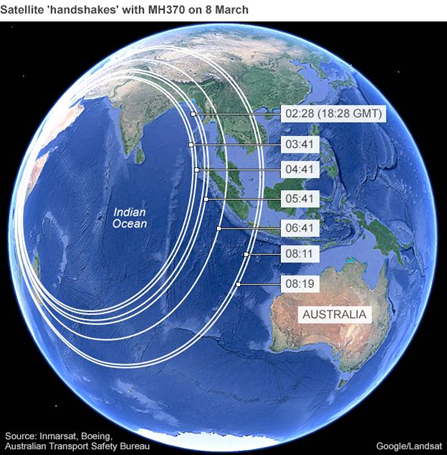
New hypothesis suggests that flight was hijacked and plane was flown for a fatal journey of no return.
The study conducted by Captain Blelly’s team suggests a sole person taking over the cockpit and intentionally flying the aircraft to avoid detection, and ultimately crashing the aircraft with all its passengers. Evidence suggests that the preplanned hijacking was carried out alone, and thorough preparations were done to navigate the southeast Asian airspace raising minimum suspicion.
As the team focused on analysing the data-backed inflight aspects, they did not strongly suggest as to who may have been leading the flight. However, as previously discovered, the two Iranians travelling on MH370 with forged passports had no ties with any terrorists’ organisations. More likely, evidence points towards the captain of the flight, Zaharie Ahmad Shah.
Captain Zaharie had flown with Malaysia Airlines for 30 years with over 18,000 hours of flight time. As will later be discussed, some of the manoeuvres the aircraft pulled in the tight airspaces prove that only a well-trained pilot could have been under control. Furthermore, records of the flight following a similar track and eventually leading to the South Indian Ocean have already been recovered from the captain’s personal Microsoft Flight Sim hard drive. While no significant sign of distress of the captain’s personal life have been discovered, the team carefully suggests that evidence most likely points towards Captain Zaharie’s suicide flight as a hypothesis.
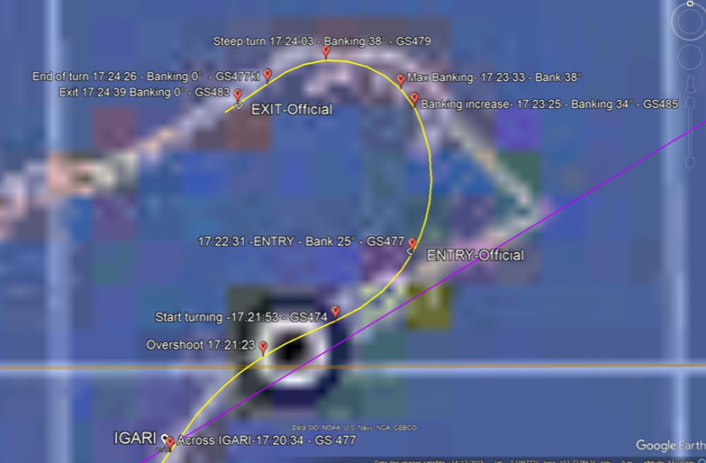
First of all, at UTC 16:50 the captain requests a climb to FL370, but ATC later clears for FL370. Although minor, this would’ve made a basis for a better cruise performance and a greater glide length during the later stages of the flight.
At UTC 17:20 the aircraft overshoots its last intended waypoint IGARI. As can be seen in the picture, the flight actually follows the yellow route rather than the purple route that was filed in its flight plan to Beijing. Had this portion of the flight been flown by autopilot the flight plan tracked by the Malaysian military radar would have resembled the purple route instead. Furthermore, as the investigation team’s simulator re-enactment proves, the flight path of the aircraft past IGARI could not have been executed by the 777’s autopilot.
The track suggests an initial bank angle of 25° later increasing up to a maximum 38°. This is above the bank angle limit protection of 30° implemented on Boeing’s autopilot control laws, suggesting a manual override. It is also speculated that if a hijacking were to have occurred it would have been right before the U turn was made. According to the team, a highly plausible scenario is that the captain waited for the copilot FO Fariq to vacate the cockpit and assume sole control of the aircraft by locking him out, resembling that of the ill-fated Germanwings flight 9525.
At UTC 17:21 MH370 disappears from all civilian radar due to both ADS-B and ACARS being shutoff.
Captain Blelly suggests whoever was in command of the aircraft had intentionally achieved this by disconnecting all four electrical generators and APU. As a result, the 777 would have been controlled with only key components supplied electrical power via the RAM Air Turbine (RAT) deployed.
With the RAT being the sole source of electricity, only the Primary Flight Display and number 1 navigation systems would be operating. Therefore, from this point onwards the pilot would have had to manually piloted the aircraft with no autopilot assist. Furthermore, the pilot in command would have depressurised the cabin intentionally.
During a loss of cabin pressure, the passenger oxygen masks exhaust their supply in roughly 22 minutes while a single pilot can last 27 hours on the cockpit oxygen supply. To fly in these austere conditions for extended durations of time is no easy feat. Thus the investigation team believes that the pilot in command must be a regular airline pilot, whom are trained to fly in these conditions during flight simulator sessions.
After the major U turn, the flight continues back towards Malaysian airspace.
At UTC 17:52 the co-pilot’s mobile phone makes a 2G connection with the Celcom Location Base Station in Penang Island. It is suggested that the co-pilot, locked out of the cockpit attempted to make a phone call in order to notify the ongoing hijacking but failed due to the weakness of the phone’s connection with the ground cell tower. By extrapolating the Celcom terrestrial antenna’s secondary lobe power diagram, the rough metrics of the flight when the phone connection was made can be deduced to be between 31,560 feet and 36,540 feet with an average ground speed of 506kts.
The Malaysian military radar track shows a relatively straight-line path after the turn near Penang between UTC 17:52 until it loses contact at UTC 18:22. However, upon closer inspection of the photos of the radar track, what should be a straight flight path is much more irregular. The pattern shown by the radar plot leads to the conclusion that this part of the flight could not have been flown under autopilot and that the aircraft was manually flown.
The last known position of MH370 according to the military radar feed is a roughly straight line continuing on to waypoint VAMPI and eventually disappearing 10Nm past waypoint MEKAR at UTC 18:22.
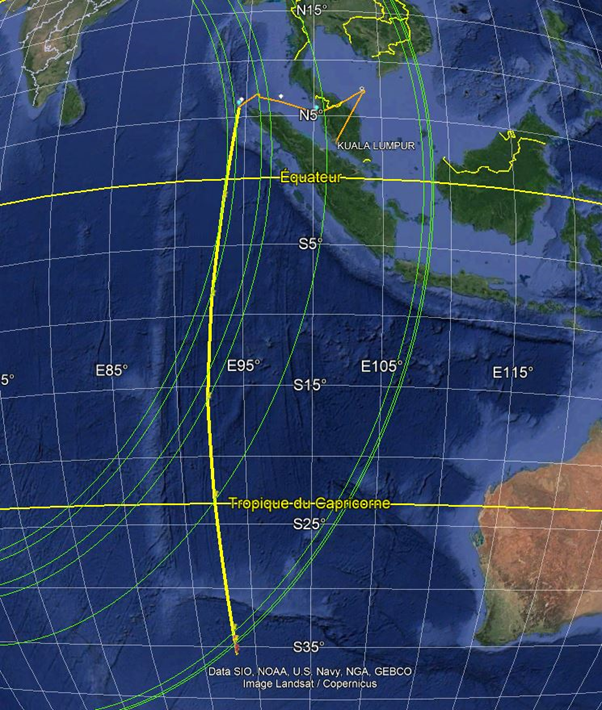
Recreating the missing part of the flight
As mentioned above, the last accurately known position of MH370 was via military radar contact roughly 10Nm after waypoint MEKAR at UTC 18:22. From this point onwards, the exact flight path MH370 took has been up to speculation. However, taking into consideration various factors such as glide slope for best cruise range, pilot’s intention, and the 7 Arcs, a sound hypothesis can be deduced.
MEKAR and the general area of MH370’s last tracked flight path is a tight airspace between the South-East Indian Air Defence Identification Zone (ADIZ) – FIR Chennai, Indonesian airspace – FIR Jakarta, and Thai airspace – FIR Bangkok. Hence, to avoid suspicion and showing minimum hostile intent in a contested area, the only logical solution for the pilot would have been to fly southwest into Indonesian airspace. From this point onwards, the hypothesis can be validated through the 7 Arcs provided by the aircraft’s communication with the Inmarsat satellite.
The investigation team’s hypothesis suggests the flight initially turned north towards waypoint NILAM and then entered FIR Jakarta through waypoint POVUS. During the transit between these two waypoints, full electrical power was restored around UTC 18:23. With a 2-minute startup time of the SATCOM, MH370 makes its first contact with the Inmarsat satellite, passing through Arc 1 at UTC 18:25.
Due to this, the aircraft starts to make automated handshakes with the Inmarsat satellite every hour, giving a total of 7 circles where the aircraft must have flown through. From the first arc onwards, the pilot is thought to maintain heading 178° using FAA/ICAO procedures for holding airspeeds at 14,001ft and above of 265kts/M0.706 at 30,000ft until crossing Arc 6. This is the route that would have taken the aircraft as far as possible with the remaining fuel on board.
By using the initial flight conditions passing Arc 1, a relatively straight path down south to Arc 6 can be recreated. Based on flight simulator re-enactments and various validating sources such as Boeing published 777-200ER performance data, the team is confident that the aircraft passed Arc 6 by coordinates 92°57’00.05″E 33°45’00.53″S at M 0.706 UTC 00:11. The final ditching point calculation is made using the crossing point of Arc 6.
The final point of ditching can be estimated using the flight conditions of MH370 passing Arc 6
The final stage of flight started past Arc 6 when the right engine flamed out due to fuel starvation. The last hourly handshake takes place at Arc 7 which was caused by the left engine manually turned off and a switch of electrical power source to APU reboots the system. It is thought that the pilot may have intentionally turned off the remaining engine in order to leave fuel for the APU to keep all control surfaces operational for a well-controlled gliding descent with full flaps: according to this theory, this would have allowed for a low speed ditching of the 777, resulting in a rather intact airframe and small number of debris. This is also in line with the difficulty in finding the remains of MH370. As for the reason for the gentle descent in the final part of the flight, we can’t but speculate: maybe the pilot wanted to extend his last minute? Or, perhaps, at the very end, he had changed his mind and tried to save the aircraft and his life? We’ll probably never know.
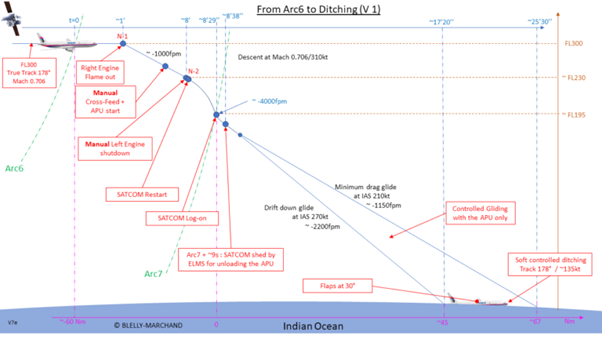
Therefore, a flight profile for the final stages of MH370 was calculated using the two locations of the aircraft calculated at Arc 6 and Arc 7. By assuming both the best and worst case scenario, the maximum and minimum distance the aircraft travelled after passing Arc 7 can be found. According to the team, the minimum ditching zone is thought to be -35.518° S 93.025° E and the maximum ditching zone -35.875° S 93.039° E. The team suggests the previous search efforts have missed the wreckage by only a few hundred kilometres south.
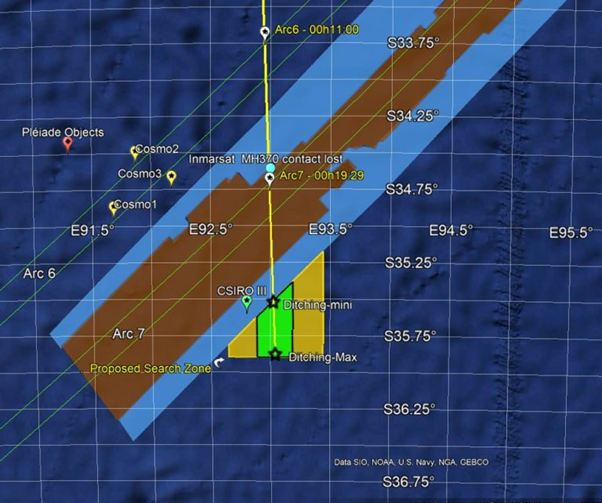
New efforts to find the wreckage of MH370
The disappearance of MH370 is nearing its ten-year mark and the general public’s interest in the case is dwindling. With all institutions involved in the accident having no real benefit in finding the wreckage, it is a truly unfortunate case for the families of those involved in the accident that no recent efforts have been made. However, with Captain Patrick Blelly and Jean-Luc Marchand’s team suggesting a highly plausible search area there is a glimmer of hope.
Ocean Infinity has also expressed interest in leading a new search effort. With the mature of submersible and underwater drone technology since 2014, there is a chance that given the newfound effort, the wreckage of MH370 may finally be discovered. With a much smaller search area proposed than before, this hypothesis of MH370’s hijacking may give the bereaved one final peace of mind.
The Author thanks Captain Patrick Blelly and Jean-Luc Marchand in their work and presentation at the Royal Aeronautical Society. A more detailed report can be found on their website mh370-caption.net/

